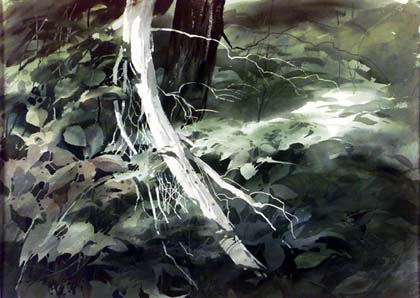
Forest Floor, circa 1968
Chicago, Illinois
watercolor, 19 3/4 by 27 1/2 inches
Illinois State Museum collection
Irving Shapiro went out into nature to make sketches, color samples, and black-and-white photographs for his watercolors. Then, back in his studio, he would begin his large paintings. He believed that only the fewest of pencil lines should be used to give guidelines to the composition, which he designed in his head. First, he applied the main color washes to define the large areas of the painting. He preferred risking mistakes while being bold and fresh with the paint, rather than risking getting bogged down in static details.
This painting shows a glimpse of the grasses, plants, and dead limbs that carpet the floor of a forest in summer. The artist used the white of the paper and dark washes to show sunlight piercing the forest canopy to cast shadows of the leaves.
Irving
Shapiro
Irving
Shapiro was born in Chicago. He studied painting at the Art Institute and
the American Academy of Art, both in Chicago. He taught art at the Academy
from 1945 until he retired. Many artists working in watercolor today mention
Shapiro as one of their teachers.
Watercolor
The characteristic
of watercolor painting that sets it apart from other types of painting
is its transparency. Watercolor consists of a thin mixture of paint pigment
(from a tube or a solid block) suspended in water. As the brush lays down
the paint, often on wet paper, the color spreads rapidly, leaving a transparent
layer of color on the paper. A watercolor painting is built of controlled
areas of wash.
Techniques
White
areas of a watercolor painting are made by covering them with a layer of
liquid rubber called masque instead of by using white paint. The
masque
is pulled off after the painting is finished and dried. That is how the
tiny twigs of Forest Floor were done.
A dry brush technique paints stronger color onto dry paper. Artists use this for adding details such as the small, dark twigs in the background of this painting.
Tools
Shapiro
used 300 or 400 pound paper, heavy enough to stay flat without stretching
or taping down. He used numbers eight and twelve round sable brushes and
flat camel's hair brushes one and two inches wide. He chose these colors
for his palette: alizarin crimson golden, light vermilion, cadmium orange,
light cadmium yellow, mauve, cobalt violet, thalo-blue, ultramarine, cerulean,
lemon yellow, sap green, thalo green, yellow ochre, burnt sienna, burnt
umber, sepia, and Payne's gray.
Shapiro, Irving. "Irving
Shapiro Says Watercolor Has Gender" American Artist. April, 1959.
Pp. 60, 92.